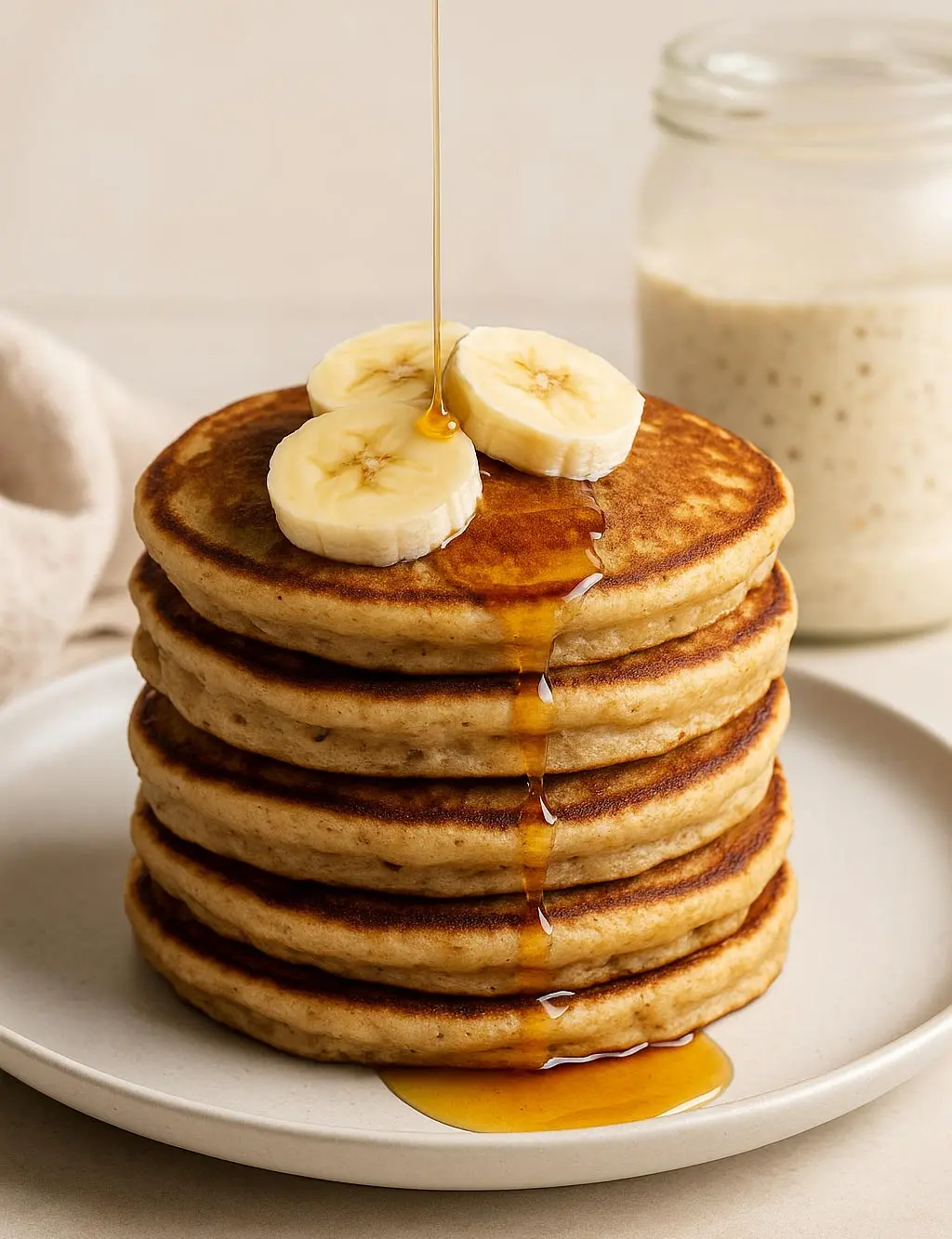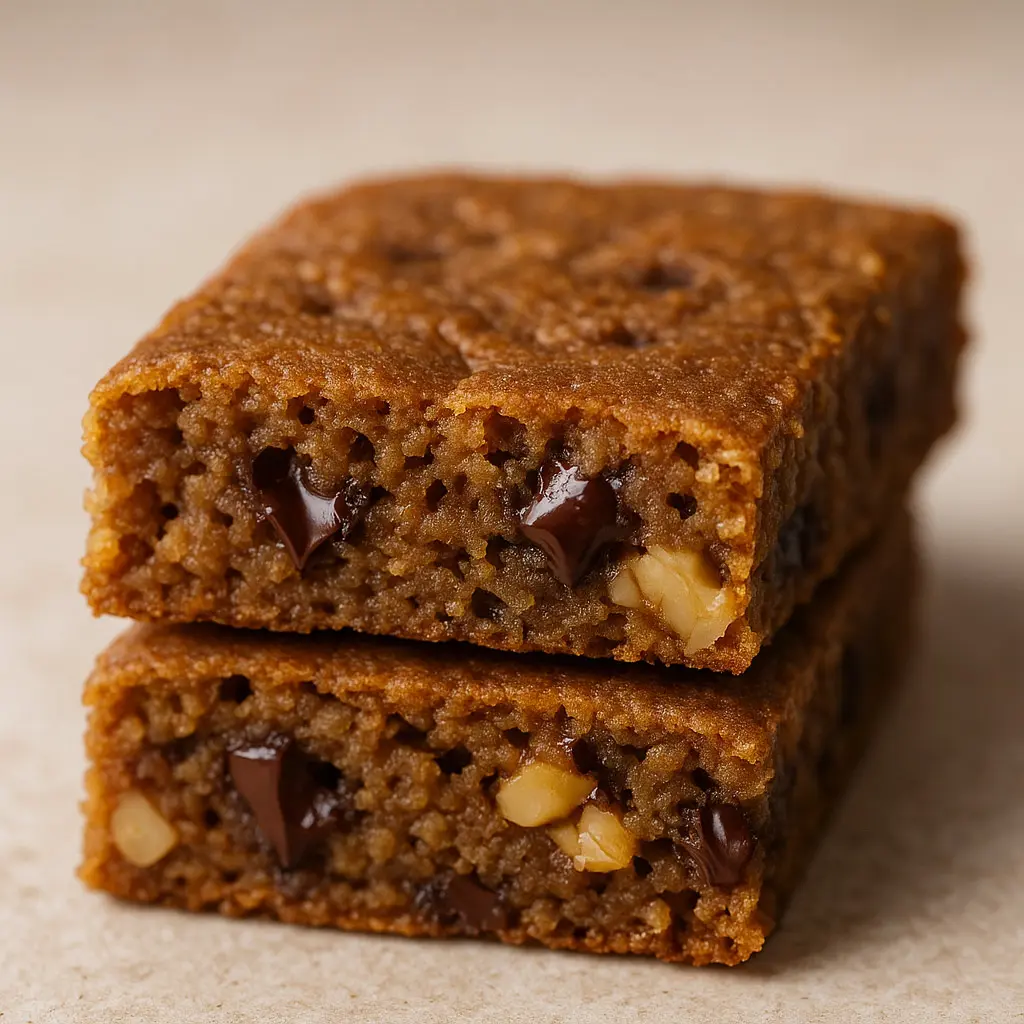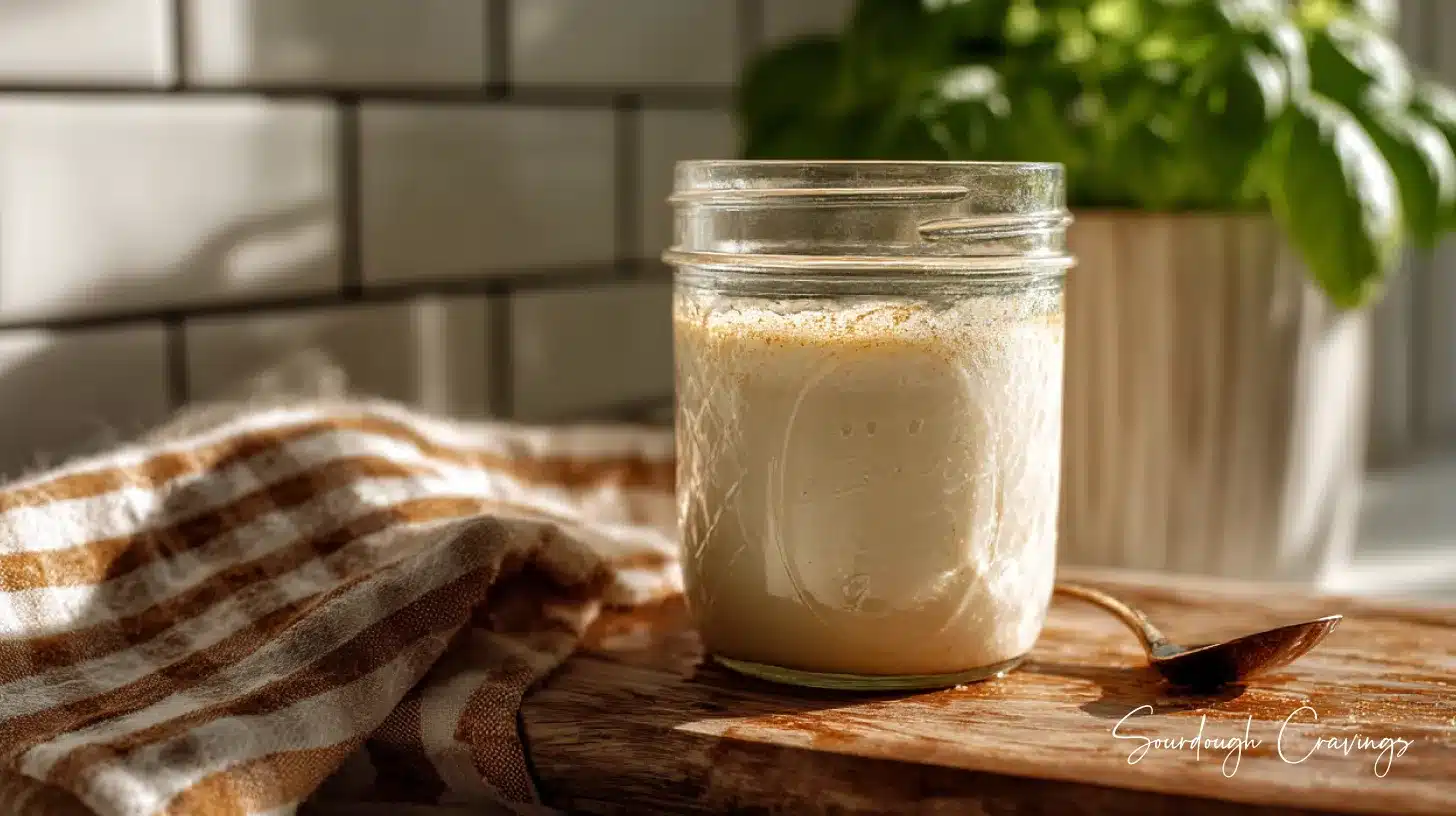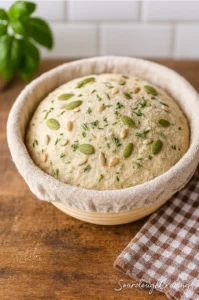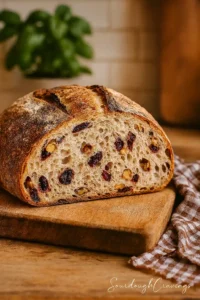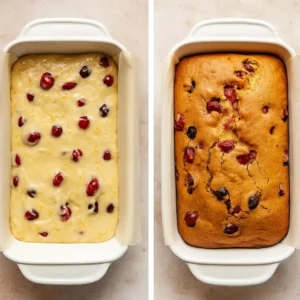Cinnamon raisin sourdough is a tender, tangy loaf dotted with juicy raisins and wrapped in warm cinnamon spice. This naturally sweet bread is chewy and golden—perfect for breakfast toast, afternoon snacks, or cozy gifting.
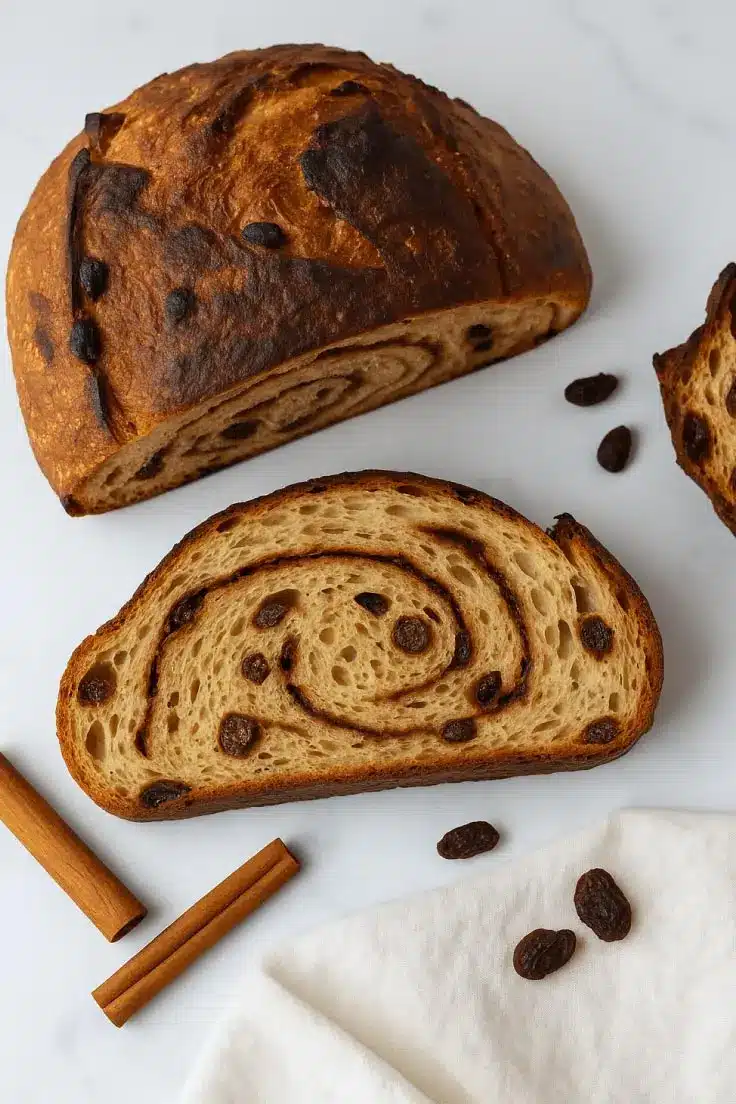
It’s a nostalgic favorite in our kitchen, born on a snowy Saturday when my kids wanted “something sweet but not dessert.” A swirl of spice, a scoop of raisins, and a little faith later… it became a weekend staple. We now bake it alongside Cranberry Orange Sourdough and Brown Sugar Cinnamon on repeat.
Table of Contents
Want to get creative with mix-ins? My Best Sourdough Inclusions guide is packed with flavorful ideas to take this loaf even further.
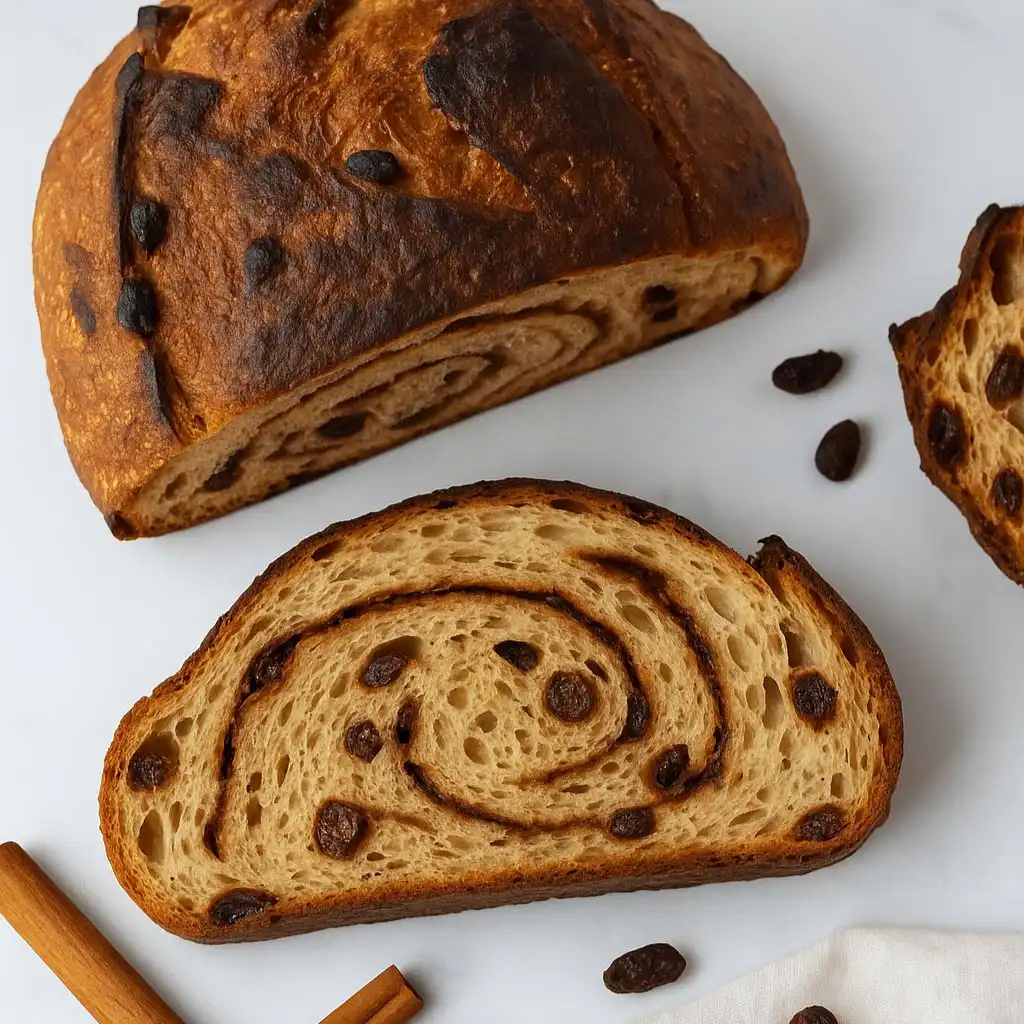
Cinnamon Raisin Sourdough
Ingredients
Method
- Mix flour and water. Let rest 30–45 minutes.

- Add sourdough starter and salt. Mix well.
- Let bulk ferment 4–5 hours with stretch & folds. Add raisins after second fold.
- Shape and optionally roll in cinnamon sugar.
- Proof in fridge overnight (8+ hours).
- Bake at 475°F covered 20 min, then uncovered 20–25 min until deep golden.
Nutrition
Notes
Loved this recipe?
Leave a rating & comment. how it was!Can Cinnamon Affect Sourdough Fermentation? Here’s the Truth
Cinnamon raisin sourdough is beloved for its cozy aroma and sweet warmth—but did you know cinnamon can actually interfere with your rise? Yep. Cinnamon contains compounds that are mildly antimicrobial, which means it can slow down sourdough fermentation if it’s mixed directly into the dough. The good news? With a few simple tweaks, your cinnamon raisin sourdough can still rise beautifully and bake up fluffy and soft.
According to this fermentation study, certain spices—including cinnamon—can reduce yeast activity when added in high amounts. That’s why many bakers opt to swirl cinnamon into the dough after bulk fermentation, rather than mixing it in early.
If you’re playing with other flavorful additions—like cocoa, cheese, or dried fruit—check out our breakdown in the Best Sourdough Inclusions: Savory & Sweet Add-Ins That Actually Work for more pro tips on what helps (or hurts) your crumb structure.
When to Add Cinnamon to Get the Best Rise
To keep your cinnamon raisin sourdough soft and airy, timing is everything. The safest method? Don’t mix the cinnamon into the dough during autolyse or bulk fermentation. Instead, add it during shaping—either sprinkled over the dough or rolled into a swirl.
That way, your wild yeast gets a head start without interference. You’ll still get those gorgeous cinnamon ribbons, just without a sluggish rise or dense interior. This approach also gives you more control over the flavor distribution—much like the technique used in our Brown Sugar Cinnamon Sourdough Bread.
If you want even more cinnamon flavor but less risk to fermentation, try adding it to the filling instead of the base dough. Trust me, your cinnamon raisin sourdough will thank you.
Keeping Raisins Plump – The Secret to Juicy Fruit Bites
If you’ve ever baked cinnamon raisin sourdough and ended up with hard little raisin nuggets in your otherwise fluffy loaf, you’re not alone. Dry raisins can zap moisture from the dough, mess with your crumb, and even burn during the bake. That’s why soaking your fruit before mixing is a total game-changer in any cinnamon raisin sourdough recipe.
Raisins act like little sponges—and if they’re dry going into the dough, they’ll pull moisture away from your loaf instead of adding to it. Soaking them in water (or better yet, orange juice or warm tea) helps them rehydrate and plump up, locking in that chewy texture we love.
How to Soak Raisins Like a Pro
For the best cinnamon raisin sourdough, soak your raisins for 10–15 minutes in warm water. Then drain them well and pat dry before folding into the dough. You can even toss them in a bit of flour so they don’t clump or streak during the fold. This keeps your inclusions well distributed and prevents any gummy spots.
Want a brighter, fruitier flavor? Soak your raisins in juice or citrus water instead. That’s a trick I picked up while testing recipes for my Cranberry Orange Sourdough Bread, and it works wonders here too.
For more on how to revive dried fruit quickly and effectively, I love this tip from America’s Test Kitchen—it’s fast, easy, and keeps the flavor intact.
Whether you’re going for a cinnamon swirl or full-on cinnamon dough, juicy raisins make all the difference in the final texture of your cinnamon raisin sourdough. Trust me, once you start soaking, you’ll never go back.
The Ultimate Cinnamon Raisin Sourdough Recipe
Once you’ve got the cinnamon timing and raisin prep down, it’s time to build your dream loaf. This cinnamon raisin sourdough is the perfect mix of tangy crust, soft crumb, warm spice, and juicy bites of fruit. Whether you’re toasting it for breakfast or snacking on it straight from the counter, it never disappoints.
The best part? It’s totally customizable. Want a richer swirl? Add brown sugar. Craving crunch? Toss in some chopped walnuts. Baking for a savory crowd instead? Try the savory flip side with something like my Jalapeño Cheddar Sourdough—a bold contrast to the sweet and spiced feel of this one.
Ingredients You’ll Need
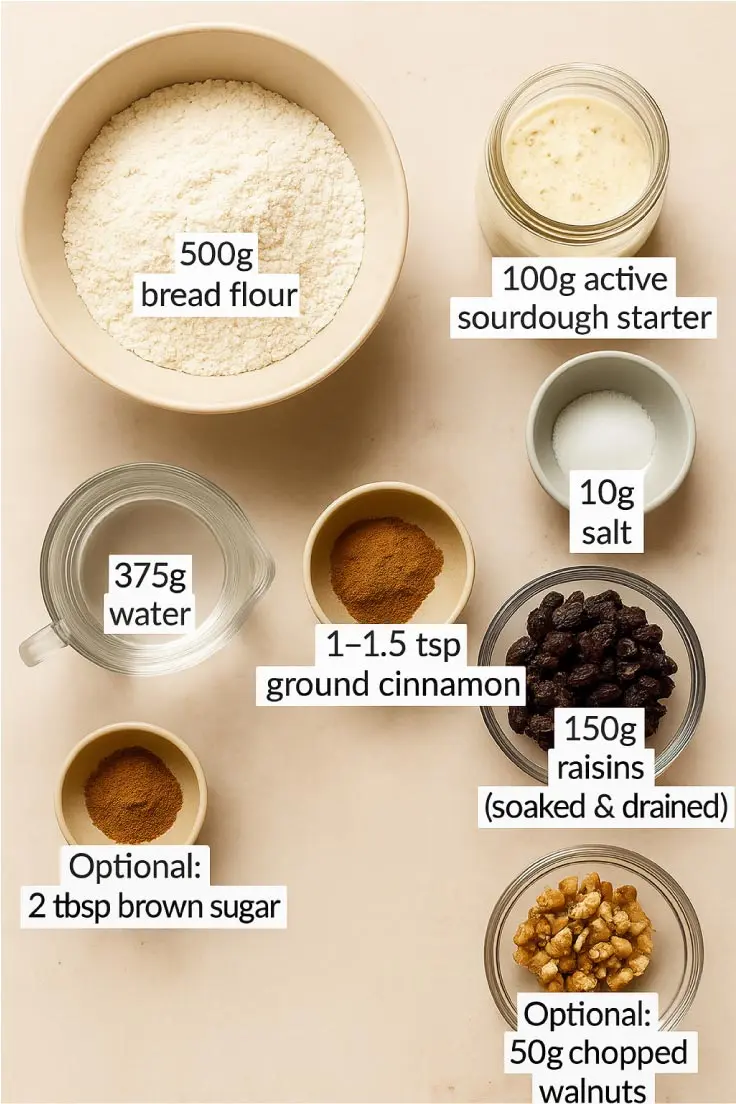
Here’s what I use for a classic cinnamon raisin sourdough loaf:
- 100g active sourdough starter
- 375g water (room temp)
- 500g bread flour
- 10g salt
- 1–1.5 tsp ground cinnamon
- 150g raisins (soaked & drained)
- Optional: 2 tbsp brown sugar, 50g chopped walnuts
This combination gives you a soft interior, bold cinnamon warmth, and sweet pops of raisin throughout the loaf.
From Starter to Slice: How to Get the Perfect Bake

1. Mix & Autolyse
Combine flour and water, and let it rest for 30–45 minutes. This helps develop gluten before the salt or cinnamon goes in.
2. Add Starter + Salt
Mix in your active sourdough starter and salt. If adding cinnamon to the whole dough, now’s the time—but expect a slightly slower bulk rise.
3. Bulk Fermentation
Let it bulk ferment 4–5 hours at room temp with 3–4 stretch-and-folds. After the second fold, gently incorporate the soaked raisins (and brown sugar or nuts, if using).
4. Pre-Shape & Swirl (Optional)
For a cinnamon swirl, flatten the dough, sprinkle cinnamon and sugar, then roll it up like cinnamon rolls before shaping.
5. Final Proof
Shape and place into a well-floured banneton. Refrigerate overnight or for at least 8 hours.
6. Bake
Preheat oven and Dutch oven to 475°F (245°C). Bake 20 minutes covered, then 20–25 uncovered until golden brown and deeply crusted.
Every step you take here supports the flavor and structure of your cinnamon raisin sourdough—from how you layer the cinnamon to how evenly those raisins are folded in. Want to get fancy? A few razor-thin apple slices on top before baking turn it into a showstopper.
Homemade vs. Store-Bought – Which Is Healthier?
When people first taste homemade cinnamon raisin sourdough, they’re usually surprised by how different it is from the store-bought stuff. It’s not just the chewy crust or the tangy depth of flavor—it’s the clean ingredients, the nutritional profile, and the fermentation magic that makes it genuinely better for you.

What You’re Actually Eating from the Store
Take a peek at the label on most supermarket cinnamon raisin breads, and you’ll see a long list of preservatives, dough conditioners, added sugar, and flavorings. Even Panera’s cinnamon swirl bread contains over 20 ingredients, including added sugar, oils, and stabilizers that give it that ultra-soft shelf-life feel—but not much else.
In contrast, homemade cinnamon raisin sourdough is made from just flour, water, salt, raisins, and cinnamon. That’s it. No funky additives. The slow fermentation process naturally develops flavor and extends shelf life without any extra junk.
Why Fermented Bread Wins Every Time
Thanks to wild yeast and time, sourdough is easier to digest than traditional bread. The fermentation process breaks down gluten and phytic acid, which can help with nutrient absorption and gut comfort. Plus, when you make cinnamon raisin sourdough at home, you control the sweetness and the mix-ins, so there’s no blood sugar spike or overly processed finish.
If you’re someone who loves exploring flavor while also watching ingredients, check out the full guide on Best Sourdough Inclusions: Savory & Sweet Add-Ins That Actually Work. You’ll see how different flavors—like roasted garlic or cranberries—balance beautifully with the structure and benefits of long-fermented dough.
Making cinnamon raisin sourdough at home isn’t just about flavor. It’s about quality, health, and bringing whole ingredients back to the center of your plate.
FAQ – Cinnamon Raisin Sourdough
Does cinnamon affect sourdough fermentation?
Yes, cinnamon can slow fermentation slightly due to its natural antifungal properties. When making cinnamon raisin sourdough, it’s best to add cinnamon later in the process—during shaping or as a swirl—so it doesn’t interfere with the activity of wild yeast. This helps maintain a good rise and avoids dense or under-proofed loaves.
Should you soak raisins before adding to sourdough?
Definitely. Soaking raisins before adding them to cinnamon raisin sourdough keeps them plump and prevents them from stealing moisture from the dough. A quick 10-minute soak in warm water—or even juice—can dramatically improve texture and ensure the raisins stay soft and juicy after baking.
Is cinnamon and raisin bread healthy?
Homemade cinnamon raisin sourdough is much healthier than most commercial versions. Thanks to slow fermentation, it’s easier to digest and often has a lower glycemic impact. With no refined sugar or preservatives, it’s a wholesome way to enjoy something sweet that’s still packed with nutrients and fiber.
Does Panera Bread make cinnamon raisin bread?
Yes, Panera Bread offers a cinnamon swirl raisin bread in their bakery section. However, their version contains added sugars, processed oils, and over 20 ingredients—unlike homemade cinnamon raisin sourdough, which can be made with just five whole ingredients and no additives.
More Sourdough Recipes Packed with Flavor
If you loved baking cinnamon raisin sourdough, get ready to dive into even more bold, flavor-packed loaves. Sweet, savory, tangy—it’s all fair game in the sourdough world, and cinnamon raisin is just the beginning.
For a deeper cinnamon swirl, check out the cozy vibes in my Brown Sugar Cinnamon Sourdough Bread. Craving a bit of heat? My Jalapeño Cheddar Sourdough brings the spicy cheese energy that balances beautifully with your sourdough tang. And if fruity loaves are your thing, you’ll fall hard for the sweet-tart combo in my Cranberry Orange Sourdough Bread—a personal favorite during the holidays.
Want even more inspiration? My ultimate guide on Best Sourdough Inclusions: Savory & Sweet Add-Ins That Actually Work walks you through everything from roasted garlic to chopped figs to get creative with your own cinnamon raisin sourdough variations.
Whether you swirl, soak, or layer your way to your next loaf, let your starter—and your cravings—lead the way.





